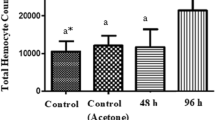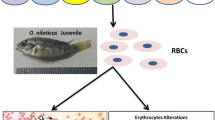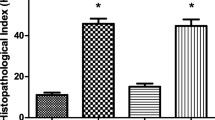Abstract
Contamination of agricultural chemicals (including pesticides) raises concerns about the safety of the aquatic ecosystem. Pretilachlor is a chloroacetamide herbicide commonly used to control weeds in field crops. Hydrophobic activity can increase the risk of pretilachlor loading into the aquatic ecosystem. Like other pesticides, pretilachlor has the potential to be toxic to non-target organisms. In particular, the toxicity of pretilachlor is in its initial stages. So, to begin with the toxicity information, we studied the short-term toxic effects of pretilachlor on edible freshwater fish, Labeo rohita. To evaluate the toxicity of pretilachlor, we determined the median-lethal concentration of 96 h. Then, we studied sublethal (1/25th of 96 h LC50) effects of pretilachlor on blood parameters (hematology, biochemical, and electrolytes) and tissue (gills, liver, and kidney) biomarkers (Na+/K+-ATPase: sodium–potassium adenosine triphosphatase, SOD: superoxide dismutase, CAT: catalase, GST: glutathione S-transferase, GPX: glutathione peroxidase, and LPO: lipoperoxidation) for 72 h. Compared with the control group, pretilachlor toxicity in the exposed group showed a significant change (p < 0.05) over the study periods. Hematological indices (excluding white blood cells and MCHC) decreased most. Sodium levels decreased, while chloride and potassium levels (excluding 24 h) increased. The basic energetic fish, glucose, and protein were declined. Pretilachlor inhibited gill Na+/K+-ATPase activity throughout the exposure periods. Pretilachlor induced oxidative stress, which we evidenced by the inhibition of SOD, CAT, GST, and GPX activities, and acceleration of LPO activity in the vital organs of fish. We conclude that pretilachlor has an effect on blood parameters and is a chemical toxic to several organs.







Similar content being viewed by others
Data availability
Not applicable.
References
Aebi H (1984) Catalase in vitro. Methods Enzymol 105:121–126. https://doi.org/10.1016/S0076-6879(84)05016-3
Awan TH, Sta Cruz PC, Chauhan BS (2016) Effect of pre-emergence herbicides and timing of soil saturation on the control of six major rice weeds and their phytotoxic effects on rice seedlings. Crop Prot 83:37–47. https://doi.org/10.1016/j.cropro.2016.01.013
Begum G (2011) Organ-specific ATPase and phosphorylase enzyme activities in a food fish exposed to a carbamate insecticide and recovery response. Fish Physiol Biochem 37(1):61–69. https://doi.org/10.1007/s10695-010-9417-4
Clasen B, Loro VL, Murussi CR, Tiecher TL, Moraes B, Zanella R (2018) Bioaccumulation and oxidative stress caused by pesticides in Cyprinus carpio reared in a rice-fish system. Sci Total Environ 626:737–743. https://doi.org/10.1016/j.scitotenv.2018.01.154
Cooper CR, Mc Daniel V (1970) The determination of glucose by the orthotoluidine method. Stand Methods Clin 6:159–170. https://doi.org/10.1016/B978-0-12-609106-9.50021-X
Devasagayam TPA, Tarachand V (1987) Decreased lipid peroxidation in rat kidneys during gestation. Biochemical and Biophysical Research Communication 145:134–138. https://doi.org/10.1016/0006-291X(87)91297-6
Doherty VF, Ladipo MK, Aneyo IA, Adeola A, Odulele WY (2016) Histopathological alterations, biochemical responses and acetylcholinesterase levels in Clarias gariepinus as biomarkers of exposure to organophosphates pesticides. Environ Monit Assess 188(5):312. https://doi.org/10.1007/s10661-016-5299-y
Drabkin DL (1946) Spectrophotometric studies xiv. The Crystallographic and Optical Properties of the Hemoglobin of Man in Comparison with Those of Other Species 164:703–723. https://doi.org/10.1016/S0021-9258(17)41272-5
Fabro L, Varca LM (2012) Pesticide usage by farmers in Pagsanjan-Lumban catchment of Laguna de Bay, Philippines. Agric Water Manag 106:27–34. https://doi.org/10.1016/j.agwat.2011.08.011
Ghayyur S, Khan MF, Tabassum S et al (2021) A comparative study on the effects of selected pesticides on hemato-biochemistry and tissue histology of freshwater fish Cirrhinus mrigala (Hamilton, 1822). Saudi J Biol Sci 28(1):603–611. https://doi.org/10.1016/j.sjbs.2020.10.049
Glaberman S, Kiwiet J, Aubee CB (2019) Evaluating the role of fish as surrogates for amphibians in pesticide ecological risk assessment. Chemosphere 235:952–958. https://doi.org/10.1016/j.chemosphere.2019.06.166
Habig WH, Pabst MJ, Jakoby WB (1974) Glutathione S-transferases. The first enzymatic step in mercapturic acid formation. J Biol Chem 249:7130–7139. https://doi.org/10.1016/S0021-9258(19)42083-8
Ji W, Sun R, Duan W et al (2017) Selective solid phase extraction of chloroacetamide herbicides from environmental water samples by amphiphilic magnetic molecularly imprinted polymers. Talanta 170:111–118. https://doi.org/10.1016/j.talanta.2017.04.005
Jiang J, Chen Y, Yu R, Zhao X, Wang Q, Cai L (2016) Pretilachlor has the potential to induce endocrine disruption, oxidative stress, apoptosis and immunotoxicity during zebrafish embryo development. Environ Toxicol Pharmacol 42:125–134. https://doi.org/10.1016/j.etap.2016.01.006
Jiang W, Gao J, Cheng Z, Wang P, Zhou Z, Liu D (2018) The effect of antibiotics on the persistence of herbicides in soil under the combined pollution. Chemosphere 204:303–309. https://doi.org/10.1016/j.chemosphere.2018.04.046
Katuli KK, Amiri BM, Massarsky A, Yelghi S, Ghasemzadeh J (2014) Impact of a short-term diazinon exposure on the osmoregulation potentiality of Caspian roach (Rutilus rutilus) fingerlings. Chemosphere 108:396–404. https://doi.org/10.1016/j.chemosphere.2014.02.038
Kaur P, Kaur P (2018) Time and temperature dependent adsorption-desorption behaviour of pretilachlor in soil. Ecotoxicol Environ Saf 161:145–155. https://doi.org/10.1016/j.ecoenv.2018.05.081
Kumar J, Patel A, Tiwari S, Tiwari S, Srivastava PK, Prasad SM (2018) Pretilachlor toxicity is decided by discrete photo-acclimatizing conditions: physiological and biochemical evidence from Anabaena sp. and Nostoc muscorum. Ecotoxicol Environ Saf 156:344–353. https://doi.org/10.1016/j.ecoenv.2018.03.008
Kumar V, Swain HS, Das BK et al (2022) Assessment of the effect of sub-lethal acute toxicity of Emamectin benzoate in Labeo rohita using multiple biomarker approach. Toxicol Rep 9:102–110. https://doi.org/10.1016/j.toxrep.2022.01.001
Lai W (2017) Pesticide use and health outcomes: evidence from agricultural water pollution in China. J Environ Economics Manag 86:93–120. https://doi.org/10.1016/j.jeem.2017.05.006
Lan J, Jia J, Liu A, Yu Z, Zhao Z (2019) Pollution levels of banned and non-banned pesticides in surface sediments from the East China Sea. Mar Pollut Bull 139:332–338. https://doi.org/10.1016/j.marpolbul.2019.01.006
Liu ZJ, Yu PM, Fang S, Fan JQ, Wang MH (2011) Development of an enzyme-linked immunosorbent assay for determination of pretilachlor in water and soil. Ecotoxicol Environ Saf 74(6):1595–1599. https://doi.org/10.1016/j.ecoenv.2011.04.026
Lowry OH, Rosebrough NJ, Farr AL, Randall RJ (1951) Protein measurement with folin-phenol reagent. J Biol Chem 193:265–275. http://www.jbc.org/content/193/1/265
Lushchak OV, Kubrak OI, Storey JM, Storey KB, Lushchak VI (2009) Low toxic herbicide Roundup induces mild oxidative stress in goldfish tissues. Chemosphere 76(7):932–937. https://doi.org/10.1016/j.chemosphere.2009.04.045
Marklund S, Marklund G (1974) Involvement of the superoxide anion radicals in autooxidation of pyrogallol as a convenient assay for superoxide dismutase. European J Biochem 47:469–474. https://doi.org/10.1111/j.1432-1033.1974.tb03714.x
Maruna RFL (1957) Determination of serum sodium by the magnesium uranyl acetate. Clin Chem Acta 2:581–585. https://doi.org/10.1016/0009-8981(57)90064-5
Mo J, Dai L, Chen L et al (2015) Structural effects of organobentonites on controlled release of pretilachlor. Appl Clay Sci 115:150–156. https://doi.org/10.1016/j.clay.2015.07.036
Mohanty SS, Jena HM (2019) A systemic assessment of the environmental impacts and remediation strategies for chloroacetanilide herbicides. J Water Process Engineering 31:100860. https://doi.org/10.1016/j.jwpe.2019.100860
Narra MR (2016) Single and cartel effect of pesticides on biochemical and haematological status of Clarias batrachus: a long-term monitoring. Chemosphere 144:966–974. https://doi.org/10.1016/j.chemosphere.2015.09.065
Narra MR, Rajender K, Reddy RR, Murty US, Begum G (2017) Insecticides induced stress response and recuperation in fish: biomarkers in blood and tissues related to oxidative damage. Chemosphere 168:350–357. https://doi.org/10.1016/j.chemosphere.2016.10.066
Nelson DA, Morris MW (1989) Basic methodology: hematology and coagulation, part IV. In: Nelson DA, Henry JB (eds) Clinical diagnosis, management by laboratory methods. W.B. Saunder Company, Philadelphia, p 578–625
Nitschke L, Schussler W (1998) Surface water pollution by herbicides from effluents of waste water treatment plants. Chemosphere 36:35–41 PII: S0045–6535(97):00286–5
Nykiel-Szymanska J, Rozalska S, Bernat P, Slaba M (2019) Assessment of oxidative stress and phospholipids alterations in chloroacetanilides-degrading Trichoderma spp. Ecotoxicol Environ Saf 184:109629. https://doi.org/10.1016/j.ecoenv.2019.109629
Ostrea EM Jr, Bielawski DM, Posecion NC Jr et al (2009) Combined analysis of prenatal (maternal hair and blood) and neonatal (infant hair, cord blood and meconium) matrices to detect fetal exposure to environmental pesticides. Environ Res 109(1):116–122. https://doi.org/10.1016/j.envres.2008.09.004
Ostrea EM Jr, Bielawski DM, Posecion NC Jr et al (2008) A comparison of infant hair, cord blood and meconium analysis to detect fetal exposure to environmental pesticides. Environ Res 106(2):277–283. https://doi.org/10.1016/j.envres.2007.08.014
Ouyang W, Zhang Y, Gu X et al (2019) Occurrence, transportation, and distribution difference of typical herbicides from estuary to bay. Environ Int 130:104858. https://doi.org/10.1016/j.envint.2019.05.052
Owolabi OD, Abdulkareem SI (2021) Carica papaya and Mangifera indica modulate haematological, biochemical and histological alterations in atrazine-intoxicated fish, Clarias gariepinus (Burchell 1822). J Basic Appl Zool 82(1). https://doi.org/10.1186/s41936-021-00241-y
Papadakis EN, Vryzas Z, Kotopoulou A, Kintzikoglou K, Makris KC, Papadopoulou-Mourkidou E (2015) A pesticide monitoring survey in rivers and lakes of northern Greece and its human and ecotoxicological risk assessment. Ecotoxicol Environ Saf 116:1–9. https://doi.org/10.1016/j.ecoenv.2015.02.033
Poopal RK, Ramesh M, Maruthappan V, Rajendran RB (2017) Potential effects of low molecular weight phthalate esters (C16H22O4 and C12H14O4) on the freshwater fish Cyprinus carpio. Toxicol Res-Uk 6(4):505–520. https://doi.org/10.1039/c7tx00084g
Prusty AK, Kohli MPS, Sahu NP et al (2011) Effect of short term exposure of fenvalerate on biochemical and haematological responses in Labeo rohita (Hamilton) fingerlings. Pestic Bioch Physiol 100(2):124–129. https://doi.org/10.1016/j.pestbp.2011.02.010
Qureshi IZ, Bibi A, Shahid S, Ghazanfar M (2016) Exposure to sub-acute doses of fipronil and buprofezin in combination or alone induces biochemical, hematological, histopathological and genotoxic damage in common carp (Cyprinus carpio L.). Aquat Toxicol 179:103–114. https://doi.org/10.1016/j.aquatox.2016.08.012
Razzaghi N, Ziarati P, Rastegar H et al (2018) The concentration and probabilistic health risk assessment of pesticide residues in commercially available olive oils in Iran. Food Chem Toxicol 120:32–40. https://doi.org/10.1016/j.fct.2018.07.002
Renuka S, Poopal RK, Ramesh M, Clara-Bindu F (2018) Responses of Labeo rohita fingerlings to N-acetyl-p-aminophenol toxicity. Ecotox Environ Safe 157:73–80. https://doi.org/10.1016/j.ecoenv.2018.03.058
Rotruck JT, Pope AL, Ganther HE, Swanson AB, Hafeman DG, Hoekstra WG (1973) Selenium: biochemical role as a component of glutathione peroxidase. Science 179:588–590. https://doi.org/10.1126/science.179.4073.588
Rusia V, Sood SK (1992) Routine hematological tests. In: Kanai L, Mukerjee I (eds) Medical Laboratory Technology. Tata McGraw Hill, New Delhi, p 252–258
Sachi ITC, Bonomo MM, Sakuragui MM et al (2021) Biochemical and morphological biomarker responses in the gills of a Neotropical fish exposed to a new flavonoid metal-insecticide. Ecotoxicol Environ Saf 208:111459. https://doi.org/10.1016/j.ecoenv.2020.111459
Schoenfeld RG, Lewellan CJ (1964) A colorimetric method for determination of serum chloride. Clin Chem 10:533–539. https://doi.org/10.1093/clinchem/10.6.533
Serafini S, de Freitas SC, Baldissera MD et al (2019) Fish exposed to eprinomectin show hepatic oxidative stress and impairment in enzymes of the phosphotransfer network. Aquaculture 508:199–205. https://doi.org/10.1016/j.aquaculture.2019.04.081
Shiosaka T, Okuda H, Fujii S (1971) Mechanism of the phosphorylation of thymidine by the culture filtrate of Clostridium perfringens and rat liver extract. Biochim Biophys Acta (BBA) 246:171–183. https://doi.org/10.1016/0005-2787(71)90125-0
Sondhia S (2019) Environmental fate of herbicide use in Central India. In: Sondhia S, Choudhury PP, Sharma AR (eds) Herbicide residue research in India, vol 12. Springer, pp 29–104
Soni R, Verma SK (2018) Acute toxicity and behavioural responses in Clarias batrachus (Linnaeus) exposed to herbicide pretilachlor. Heliyon 4(12):e01090. https://doi.org/10.1016/j.heliyon.2018.e01090
Soni R, Verma SK (2020) Impact of herbicide pretilachlor on reproductive physiology of walking catfish, Clarias batrachus (Linnaeus). Fish Physiol Biochem 46(6):2065–2072. https://doi.org/10.1007/s10695-020-00853-1
Stara A, Bellinvia R, Velisek J, Strouhova A, Kouba A, Faggio C (2019) Acute exposure of common yabby (Cherax destructor) to the neonicotinoid pesticide. Sci Total Environ 665:718–723. https://doi.org/10.1016/j.scitotenv.2019.02.202
Sunderman FW, Sunderman FW (1958) The rapid colorimetric estimation of potassium. American J Clinical Pathol 29:95–103. https://doi.org/10.1093/ajcp/29.2.95
Tabassum H, Ashafaq M, Khan J, Shah MZ, Raisuddin S, Parvez S (2016) Short term exposure of pendimethalin induces biochemical and histological perturbations in liver, kidney and gill of freshwater fish. Ecol Ind 63:29–36. https://doi.org/10.1016/j.ecolind.2015.11.044
Tabassum S, Rakhi SF, Reza A, Mollah MFA, Hossain Z (2020) Potential attenuation of biochemical parameters and enzymatic functions in Cyprinus carpio fingerlings by Phenthoate 50 EC insecticide exposure. Environ Sci Pollut Res Int 27(28):35837–35851. https://doi.org/10.1007/s11356-020-09697-x
Tanabe A, Mitobe H, Kawata K, Sakai M (1996) Monitoring of herbicides in river water by gas chromatography-mass spectrometry and soil-phase extraction. J Chromatography A 754:159–168 PII: S0021–9673(96):00221-X
Toan PV, Sebesvari Z, Blasing M, Rosendahl I, Renaud FG (2013) Pesticide management and their residues in sediments and surface and drinking water in the Mekong Delta. Vietnam Sci Total Environ 452–453:28–39. https://doi.org/10.1016/j.scitotenv.2013.02.026
Veedu SK, Ayyasamy G, Tamilselvan H, Ramesh M (2022) Single and joint toxicity assessment of acetamiprid and thiamethoxam neonicotinoids pesticides on biochemical indices and antioxidant enzyme activities of a freshwater fish Catla catla. Comp Biochem Physiol C Toxicol Pharmacol 257:109336. https://doi.org/10.1016/j.cbpc.2022.109336
Wang G-X, Watanabe H, Uchino A, Itoh K (2000) Response of a sulfonylurea (su)-resistant biotype of Limnophila sessiliflora to selected su and alternative herbicides. Pestici Biochem Physiol 68(2):59–66. https://doi.org/10.1006/pest.2000.2504
WHO (2009) The WHO recommended classification of pesticide by hazard and Guidelines to classification In: WHO (ed). WHO Press, Switzerland p1–78
Yang L, Li H, Zhang Y, Jiao N (2019) Environmental risk assessment of triazine herbicides in the Bohai Sea and the Yellow Sea and their toxicity to phytoplankton at environmental concentrations. Environ Int 133(Pt A):105175. https://doi.org/10.1016/j.envint.2019.105175
Zaidon SZ, Ho YB, Hamsan H, Hashim Z, Saari N, Praveena SM (2019) Improved QuEChERS and solid phase extraction for multi-residue analysis of pesticides in paddy soil and water using ultra-high performance liquid chromatography tandem mass spectrometry. Microchem J 145:614–621. https://doi.org/10.1016/j.microc.2018.11.025
Zhao F, Li H, Cao F, Chen X, Liang Y, Qiu L (2019) Short-term developmental toxicity and potential mechanisms of the herbicide metamifop to zebrafish (Danio rerio) embryos. Chemosphere 236:124590. https://doi.org/10.1016/j.chemosphere.2019.124590
Author information
Authors and Affiliations
Contributions
M.R.: supervision, review, funding acquisition. M.P.: methodology, data curation. R.T.: methodology, data curation. R.K.P: methodology, writing—draft (original and revisions). Z.R.: Review. B.L.: writing—draft, review.
Corresponding authors
Ethics declarations
Funding
We thank Foreign Youth Talent 2022 (QN2022024001L), the National Foreign Youth Talen Program, Department of Science and Technology Bureau, China. We thank the UGC, New Delhi, India.
Conflict of interest
The authors declare no competing interests.
Ethical approval
The experiment protocol was following the advices of university ethical committee—the Committee for the Purpose of Control and Supervision of Experiments on Animals (CPCSEA), Government of India.
Informed consent
For this type of study informed consent is not required.
Consent for publication
For this type of study consent for publication is not required.
Additional information
Publisher's Note
Springer Nature remains neutral with regard to jurisdictional claims in published maps and institutional affiliations.
Rights and permissions
Springer Nature or its licensor (e.g. a society or other partner) holds exclusive rights to this article under a publishing agreement with the author(s) or other rightsholder(s); author self-archiving of the accepted manuscript version of this article is solely governed by the terms of such publishing agreement and applicable law.
About this article
Cite this article
Ramesh, M., Priyanka, M., Tamilarasi, R. et al. Short-term toxicity of chloroacetanilide herbicide on non-target organism: estimation of median-lethal concentration, hematological, biochemical, ion regulation, and antioxidants. Comp Clin Pathol 32, 125–137 (2023). https://doi.org/10.1007/s00580-022-03422-5
Received:
Accepted:
Published:
Issue Date:
DOI: https://doi.org/10.1007/s00580-022-03422-5




